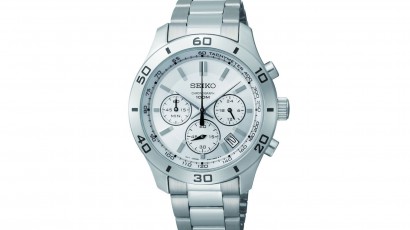
How To Find A Great Watch On A Tight Budget

Seiko
“You’ll know a bad one when you pick it up. The quality — or lack thereof — shows itself instantly.“
A man needs a watch, but most of us can’t justify taking out a second mortgage to finance our horological investments. Lucky for you, we’ve created a series of guides to help you get the most watch for your money. Whether you have a $250, $500, $1,000 or $1,500 to spend, we’ve got you covered. In this installment, we’re looking at watches for the tightest budget.
You’re looking for a watch, and you’ve got $250 to spend. What can you expect for your hard-earned? There are a lot of great watches to be found in this range, but there are definitely specific features you need to look for.
Here’s what you need to know before hitting the street — or the web — to look for the one piece of jewelry that best defines who you are as a guy.
Here’s what you should expect for $250
Typically the movement (the internal mechanism of the watch) will be from Japan or China. It’ll usually be quartz — it’ll say so on the dial. A quartz movement keeps time by using the electronically charged vibrations of a quartz crystal and needs its batteries replaced periodically. You’ll find mechanicals here and there (springs and gears and tick-tick-tick), both hand wound (once a day, please) and automatic (wound from the motion of your wrist), especially in watches of Chinese make.
One note: If you need accuracy, forget mechanical. Unless it’s a very cheap, poorly made movement, quartz is miles ahead in accuracy — until you spend a lot of money, that is
You’ll see mineral glass crystals, occasionally sapphire (the crystal is the “window” over the face, or dial, of the watch). Mineral glass isn’t as hard or tough as sapphire (when we say sapphire, we mean a colourless man-made version of the gemstone), but you don’t need sapphire in a dress or casual watch.
But if your watch will see the pressures and rigors of, say, scuba diving or a hard day at the construction site (dive watches are a good choice for situations prone to abuse), you need the toughness of sapphire. You’ll find mineral glass in some dive watches, but that’s your signal to keep looking.
A push-pull crown — the knob on the side of the watch — works great for casual and dress watches. Pull it out to set the time. Push it back in to let the watch run. If you’re going in the water, though — even in light swimming and snorkeling situations — go straight to the watch with a screw-down crown. (A screw-down crown actually screws onto the side of the case, sealing one or more gaskets in the process.) Anything less is asking for your watch to get flooded, and no one wants that.
Metal bracelets and clasps should be tight, strong and easy to operate, with minimal rattling. You’ll know a bad one when you pick it up. The quality — or lack thereof — shows itself instantly. If you’re looking for a leather or rubber strap, make sure the seams are well sewn, that there’s no mold flashing on the rubber and no sharp corners on the buckle. Rubber straps are great for a casual look. You’ll see them on some dive and sport watches.
Finally, a word about digital (numbers) vs. analogue (hands) displays. Timepieces intended for use in the outdoors and backcountry have so many functions and indications (barometer/altitude, compass direction, temperature, timers, etc.) besides telling the time that an analogue display is impractical. If you spend significant time in the backwoods or mountains, you’re going to need to go digital.